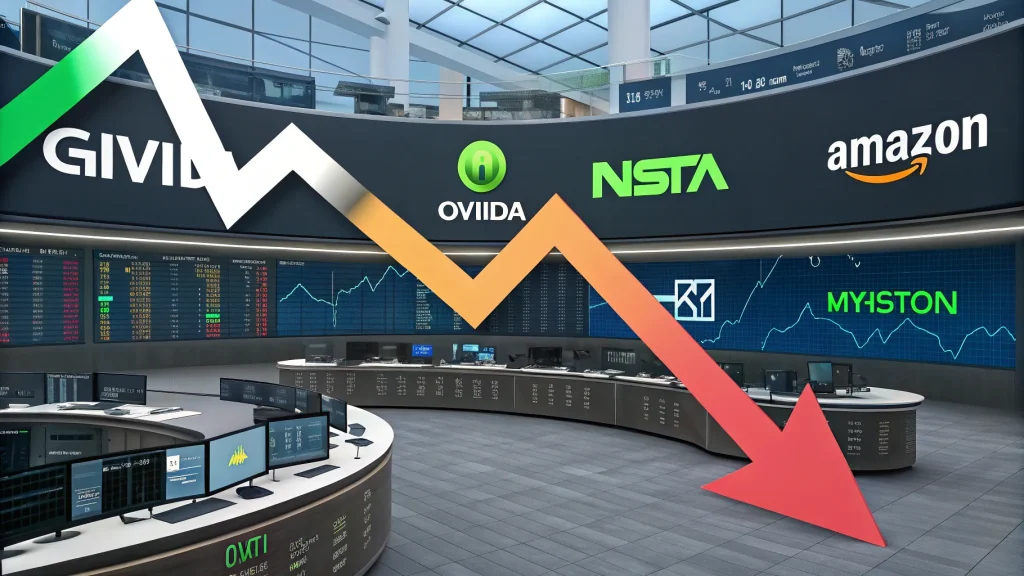Tech leaders are dropping hard. NVIDIA is down about 15%. Microsoft is off roughly 14%. Amazon has slid about 15%. Meta has fallen about 27% from its recent peak. I warned that this air pocket might come. Now we are seeing it across the screen.
The main message is simple. The artificial intelligence buildout is hitting a wall of scrutiny. Cash burn is heavy, replacement cycles are short, and proof of profit is thin. Add mixed signals from key players, and the market’s mood shifted fast. As CEO of LifeGoal Wealth Advisors and a CIMA and CFP professional, I look at these swings through a simple lens: cash flows, time, and trust. Right now, all three are in question for the biggest AI backers.
Table of Contents
ToggleWhat Changed in the Market’s Mood
For a year, investors cheered every press release about new AI capacity. Companies were treated like heroes for spending on GPUs, data centers, and model training. That phase ended almost overnight. The market is no longer paying up for spend. It is asking for earnings.
“The market has gone from rewarding them for acting like drunken sailors spending on AI to crucifying them.”
That may sound harsh. But it captures the flip. When the bill comes due and returns are unclear, stocks re-rate lower. We are now in that sober assessment stage.
View this post on Instagram
The Three Pressures Hitting the Tech Titans
- Short replacement cycle. AI chips have a useful life of about three years in cutting-edge tasks. That means today’s massive spend will repeat soon.
- Investment pullback signals. NVIDIA signaled “just kidding” about a promised $100 billion investment in OpenAI. Markets hate mixed messages on cash commitments of that size.
- Leadership questions at OpenAI. Concerns around Sam Altman’s judgment add key-man risk to the AI story that many investors had treated as a straight line up.
Each item on its own is manageable. Together, they hit growth stories where it hurts: confidence in future cash flow and faith in management follow-through.
The AI Spend Is Huge—And It Ages Fast
Let me start with the replacement cycle. In AI, hardware ages at warp speed. New chips arrive with significant gains every year. The machines bought today can be outclassed in two or three years. If you are Amazon, Microsoft, or Meta, you cannot let your core AI stack lag. That means writing new checks again and again.
This is not like a power plant, you depreciate for 30 years. It is more like phones, but with far bigger dollar signs. If a company spends tens of billions today, it may need to pay tens of billions again a few years later. That is a treadmill. Treadmills eat cash if revenue does not catch up quickly.
Here is the tension. Many AI services are still loss leaders. They build reach, not profits. The gap between spend and cash returns has widened. Investors are no longer assuming the gap will close on its own.
The Profit Math the Market Wants to See
Markets are simple in the end. Cash in must exceed cash out. Timing matters too. If a company spends $50 billion and expects payback in five to seven years, that is a bet. It can be a wise bet if pricing power sticks, usage grows, and costs fall. It can be a poor bet if the next chip cycle resets the race before payback arrives.
The current selloff says this: show the path to profit on the AI stack. Investors want proof of margin expansion. They want pricing tied to outcomes. They want to see internal adoption lifting productivity, not only buzz. They want unit economics that improve as scale grows, not worsen with each new cycle of spend.
So far, some results look mixed. AI helps search, ads, and cloud upsells, but the scale of spend dwarfs the near-term gains. The market’s patience has limits. Earnings guidance that doesn’t reflect clear payback gets punished.
NVIDIA’s OpenAI Investment Signal
NVIDIA has been the gear supplier to the entire boom. The company had been linked to a $100 billion investment plan with OpenAI. Then we got a version of “just kidding.” Whether that line was firm or soft is less important than the signal it sends. If the leading supplier hesitates on the size and shape of investment in a key partner, everyone reassesses their own risk.
Wall Street took it as a “check your assumptions” moment. Big numbers tossed around without a cemented structure are not cash flows. They are options. Options can get pulled. That is what investors priced in. When structure weakens, valuation follows.
Leadership Risk at the Center of AI
Leadership matters in high-spend, high-stakes buildouts. Sam Altman is the face of a central AI platform. He is brilliant, driven, and polarizing at times. Lately, questions have grown about his style and the reliability of his guidance. Fair or not, those doubts raise risk premiums for anyone tied closely to his plans.
Investors can accept technological risk. They struggle with governance risk. Key-man questions increase volatility because they can alter strategy, partner ties, and hiring. When the market becomes unsure about the steady hand at the wheel, stocks connected to that wheel feel it.
From Growth at Any Cost to Show Me the Money
We have seen this movie before. In the cloud’s early years, spending surged and profits lagged. Over time, usage rose, costs fell, and margins improved. The difference now is the speed of obsolescence and the size of the tab. AI chips and data center designs face rapid change. The dollar amounts hit triple digits in billions. The margin of error is thin.
That is why multiples are compressing. When the path to durable free cash flow looks less clear, the market cuts the price it is willing to pay for future growth. Price-to-earnings ratios step down. Share prices fall even if revenue keeps rising. This is not a verdict on the long-term value of AI. It is a repricing of near-term risk and timing.
What I Told Listeners and What I’m Seeing Now
I said on my podcast that the market would shift from cheering capex to grading results. That is now in play. The data points arrived quickly: a deep chip-replacement cycle, a walk-back on a headline investment, and leadership questions. Together, they created a clean hit to sentiment.
As a portfolio manager, I look for inflection points. This is one. It does not mean sell everything. It does mean adjust your expectations. The easy multiple expansion phase is over for now. To regain altitude, the sector must show profit growth that beats the cash burn. Guidance must reflect hard unit economics, not only vision.
What Could Turn Sentiment
Three things could help.
- Clear ROI proof. Evidence that AI features lift pricing and cut costs in core products. Ideally, with gross margin gains that stick.
- More durable hardware cycles. A longer life for top-tier chips would lower replacement intensity and improve payback math.
- Governance calm. Stable leadership and consistent messages from key players would rebuild trust in the investment story.
Any one of these would support a rebound. All three would push it further. Right now, none are obvious. So the market is asking for patience and proof.
Risks That Still Do Not Get Enough Attention
There are also more subtle pressures. Power constraints limit how fast data centers can grow. That makes deployment more complex and more costly. Supply chains for the highest-end chips remain tight. That pushes prices up and schedules out.
Customer behavior is another blind spot. AI is impressive, but many users still test rather than commit. Enterprises run pilots. They hold back on full rollouts. Until adoption is wide and sticky, revenue is choppy. That creates a mismatch with the steady cadence of hardware spending.
Competition also bites. Each cloud vendor tries to lock in customers with custom tools. That can win accounts, but it also limits pricing freedom if rivals match features fast. In software, moats can shrink quickly when code moves and models improve in public. The result is a race with fewer toll booths than bulls once expected.
What This Means for Everyday Investors
Here is how I’m thinking about positioning, not as advice for your unique situation, but as a guide to the forces at work.
First, separate the AI story into layers. There are chip makers, data center operators, cloud platforms, software companies, and end users. Each layer has its own risk and payback profile. Chip suppliers gain early when buildouts surge. Platforms gain later if usage and pricing power grow. Software and end users gain when AI cuts costs and lifts productivity.
Second, time your expectations. If your thesis rests on chip sell-through, watch orders and lead times. If it rests on platform margins, track attach rates and price per compute hour. If it rests on software, watch seat growth and renewals. Match your holding period to the layer you are backing.
Third, resist hero worship. Leaders can inspire. They can also misstep. Tie your conviction to measurable progress: revenue mix, gross margin, capex discipline, cash flow. If the numbers improve, the stock can recover even if headlines stay noisy. If the numbers stall, headlines will not save it.
How I’m Reading the Current Pullback
This looks like a repricing, not a structural collapse. The use cases for AI are real and growing. But the capital cycle is harsher than many expected. The leaders must prove they can convert spend into durable profits before the next refresh cycle hits. Until then, the market will mark down the promise and mark up the risk.
We have seen this pattern across many tech waves. Hype, heavy capex, doubt, proof, then a new climb. The timing and the winners vary. The key is to track the proof phase closely. The proof here is margin expansion and cash returns that exceed the cost of capital.
What I’m Watching Next
I’m tracking a few signposts:
- Capex guides from Amazon, Microsoft, Meta, and others for the next 12–24 months.
- Evidence of longer chip life or more efficient compute per dollar.
- Cloud pricing for AI services and any moves to usage-based tiers that lift margins.
- Enterprise adoption beyond pilots, measured by contract sizes and renewals.
- Stability signals from OpenAI and its key partners.
If these turn positive, the sector can regain footing. If they weaken, the reset may continue.
I’m not bearish on the long-term promise of AI. I am sober about the costs and the time needed to earn a return on those costs. That is where the market sits today as well. Stocks move on cash and confidence. Both took a hit. They can heal, but it will take proof, not promises.
For now, expect choppier trade in the giants. Expect more focus on unit economics on earnings calls. Expect management teams to talk less about buildouts and more about payback. That shift is healthy. It is how hype becomes value. It is also how investors avoid paying for dreams that never turn into dollars.
The takeaway is clear. The AI wave is real, but the easy gains are gone for the moment. The next leg up will come from execution. Show the money, and the market will return. Until then, I’m watching the numbers and keeping expectations grounded.
Frequently Asked Questions
Q: Why are AI-related stocks falling after months of strength?
The market shifted from cheering spending to demanding profits. Short hardware cycles, huge capex, and leadership uncertainty raised doubts about near-term cash returns and pushed valuations lower.
Q: How long do companies need to invest before AI becomes profitable?
It depends on the layer. Hardware may pay off faster during buildouts, while platforms and software need time for adoption and pricing to catch up. Proof will show in the margins and free cash flow.
Q: What signs would suggest the selloff is nearing an end?
Watch for clearer ROI, improving gross margins on AI services, longer chip life, or better efficiency per dollar, steadier leadership signals, and enterprise adoption that moves from pilots to broad rollouts.

















